Physiotherapy Management Of Ankle Sprains
Call Us:
+91-9421750231, +91-7875411115.

does physiotherapy exercises for ankle pain help?
A Physiotherapist will take a history of your ankle pain together with special tests and watching how your ankle generally moves to diagnose your pain. Treatment after an acute ankle injury (such as a sprain) should always consist of the OECD principles (rest, ice, compress, elevate, do no harm). Following this period remaining active movements of the ankle joint need to occur (e.g drawing letters of the alphabet with your ankle) as well as improving strength, balance and proprioception through specific exercises as guided by your Physiotherapist.
For most ankle-related pain, a short period of reducing or modifying high impact or weight-bearing activities can be helpful in the early interim, especially in instances where tendinopathy or acute episodes of arthritic-related pain are present. Alternative activities such as bike riding or swimming can be safe and even beneficial during this time, however should be advised by a health professional before commencing. Depending on assessment findings, other specific non-weight bearing strengthening exercises may be prescribed that include theraband resisted movements of the ankle joint.
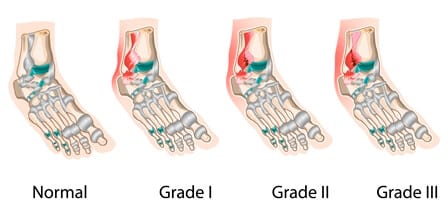
What are the most common types of ankle sprains?
gRADE i
The sprain causes little damage to the ligaments, and although the ankle will be tender for a few days, you can walk on it after a short period of rest.
- Rest your ankle by not walking on it.
Ice should be immediately applied to keep the swelling down. - Compression dressings, bandages, or ace wraps will immobilize and support your injured ankle.
- Elevate your ankle above the level of your heart as often as possible during the first 48 hours.
GRADE II
Ina grade 2 sprain, the ligament is partially torn. It is difficult to walk. A grade 2 sprained ankle will result in significant swelling and bruising. It is possible, though not as likely, to need surgery for a grade 2 sprain, depending on the severity of the sprain.
- Partial tearing of the ligament
- Moderate tenderness and swelling around the ankle
- If the doctor moves the ankle in certain ways, there is an abnormal looseness of the ankle joint
GRADE III
This is a full tear of the ankle ligament. You may have heard a popping sound when it happened. This level of sprain causes severe pain, swelling and bruising. Because the ligament is no longer able to do its job, your ankle will feel unstable and will be unable to support any of your weight.
- Complete tear of the ligament
- Significant tenderness and swelling around the ankle
- If the doctor pulls or pushes on the ankle joint in certain movements, substantial instability occurs
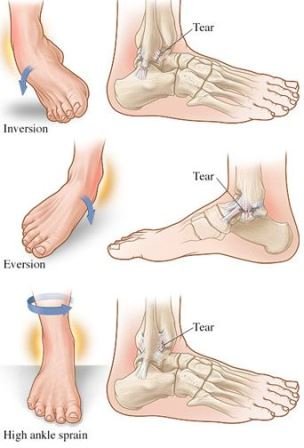
Various types of Ankle pain
Sprained ankle
An injury that occurs when the ankle rolls, twists or turns in an awkward way.
This can stretch or tear the tough bands of tissue (ligaments) that help hold the ankle bones together.A sprained ankle causes swelling, pain and limited range of motion. Many people simply treat a sprained ankle at home with rest, ice and pain relievers. Severe sprains may need medical evaluation.
Sprains and strains
Ligaments help stabilize joints, preventing excessive movement. A sprained ankle occurs when the ligaments are forced beyond their normal range of motion. Most sprained ankles involve injuries to the ligaments on the outer side of the ankle.
Tendonitis
Tendinitis, also known as tendonitis, is the inflammation of a tendon. It happens when a person overuses or injures a tendon, for example, during sport. It is normally linked to an acute injury with inflammation. It often affects the elbow, wrist, finger, thigh, and other parts of the body.
Arthritis
Different types of arthritis exist, each with different causes including wear and tear, infections and underlying diseases. Symptoms include pain, swelling, reduced range of motion and stiffness. Medication, physiotherapy or sometimes surgery helps reduce symptoms and improve quality of life.
SPECIAL TEST for assessment of ankle stability

Prone anterior drawer test
The Prone Anterior Drawer Test of the ankle is an orthopedic test used to assess the integrity of the lateral collateral ligaments of the ankle viz: anterior talofibular, calcaneofibular and posterior talofibular ligaments.
talar tilt test ankle
The talar tilt test, or inversion stress maneuver, is performed with the patient supine or on his/her side, with the foot relaxed. The gastrocnemius must also be relaxed by flexion of the knee. The talus is then tilted from side to side into adduction and abduction.
proprioception test ankle
To perform the test, touch each of your fingers to your thumb, starting with your forefinger. Distal proprioception test. The tester will hold the sides of your big toe and perform up and down movements while you watch. You then have to repeat the same movement with your eyes closed.
COMMON ankle pain physiotherapy treatment at home INCLUDE
Start each exercise slowly and use your pain level to guide you in doing these exercises. Ease off the exercise if you have more than mild pain. Following are some examples of typical rehabilitation (rehab) exercises. Keep in mind that the timing and type of rehab exercises recommended for you may vary according to your doctor’s or physical therapist’s preferences.
Rehabilitation (rehab) exercises are critical to ensure that the ankle heals completely and reinjury does not occur.
- You can begin healing by walking or bearing some weight while using crutches if needed if you can do so without too much pain.
- Start rehab with range-of-motion exercises in the first 72 hours after your injury. Continue with further rehab, including stretching, strength training, and balance exercises, over the next several weeks to months.
- You can do rehab exercises at home or even at the office to strengthen your ankle.
Physiotherapy for Ankle pain TECHNIQUES ARE:
- Patient education
- Range-of-motion exercises
- Stretching exercises
- Footwear Modification
- Ultrasound Therapy
- Bracing
- Balance and control exercises
Physiotherapy exercises For Ankle pain
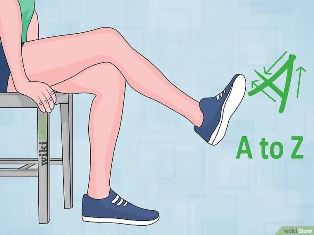
Ankle alphabet
Sit on a couch or comfortable chair. Extend your leg out and trace the letters of the alphabet in the air with your big toe. If there’s no pain, you can repeat this 2 or 3 times. This gentle exercise helps you to move your ankle in all directions.
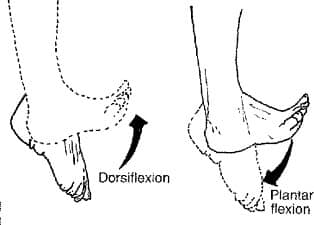
Ankle toe movement
Ankle pumping exercises utilize a calf muscle pump function to pump blood to the heart by muscle contraction. Ankle pumping exercises are often used for the relief of edema3) and the prevention of deep vein thrombosis (DVT), which are associated with prolonged bed rest.
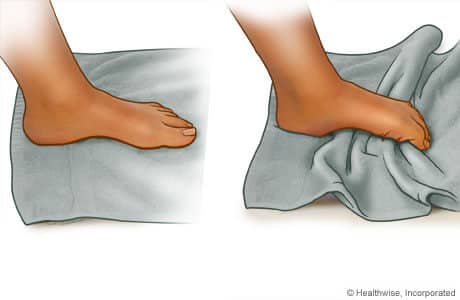
Towel and tissue scrunches
- Sit in a chair and place a towel under your foot. Make sure that your foot stays in a downward pointed position throughout the exercise. Use your toes to scrunch the towel closer to you. Make sure your ankle and knee do not move during the exercise.

Muscle Energy Technique (MET)
Muscle Energy Technique (MET) is a technique that was developed in 1948 by Fred Mitchell, Sr, D.O. It is a form of manual therapy, widely used in Osteopathy, that uses a muscle’s own energy in the form of gentle isometric contractions to relax the muscles via autogenic or reciprocal inhibition and lengthen the muscle.

Ankle Towel stretch
- The towel rotation stretch is a great exercise to help improve the flexibility and range of motion of your shoulder. It is actually a combination of three motions around the shoulder: internal rotation, adduction (moving your shoulder closer to the body), and extension.

Standing calf stretch
- Your Achilles tendon connects the muscles in the back of your leg to your heel bone. The calf stretch exercise can help prevent an Achilles tendon rupture.
- Now begin to bend the knee with your front leg whilst moving your chest towards the wall until you feel a stretch in the back of your calf muscle. Hold for 20 seconds.
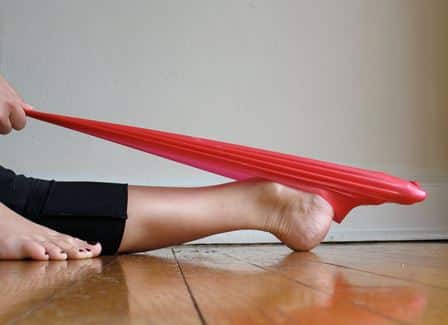
Elastic band push
- If you can do a proper knee push-up or regular push-up, then the Resistance Band Push-Up is a great way to increase the challenge. … Here are the steps to performing a Resistance Band Push-Up: 1) Wrap band around back just under armpits, while holding handles, loop the band and extra time around each hand to tighten it.

Ankle out
Tie your resistance band around a heavy object. Sit or stand and hook the inside of your foot into the end of the band. Slowly move your foot to the outside and back. Repeat 10 times at first, and build up to 20 times.
You can also do this while sitting down with your ankle propped up on a rolled towel or noodle. Tie a loop at the end of the resistance band and hook it around your foot. Now arrange the band to also go around your good foot. Your good foot acts as a pivot. Holding on to the end of the band, turn your ankle out. Repeat 10 times at first, and build up to 20 times.

Pillow balance with eyes closed
This is the most challenging exercise. See how long you can hold your balance while standing on a pillow with your eyes closed. Be sure to have something available for support. Work up to 30 seconds to 1 minute if you can. But don’t be discouraged if you can’t.
With these exercises, you’re retraining and improving the signals between your ankle and your brain.
FREQUENTLY ASKED QUESTIONS
Can physiotherapy cure ankle pain?
Treating a sprained ankle can help prevent ongoing ankle problems. Rehabilitation (rehab) exercises are critical to ensure that the ankle heals completely and reinjury does not occur. You can begin healing by walking or bearing some weight, while using crutches if needed if you can do so without too much pain.
How long does it take to recover from ankle pain?
Mild, low-grade ankle sprains will usually heal in one to three weeks with proper rest and non-surgical care( such as applying ice). Moderate injuries may take between three and four weeks. Because of limited blood flow to the ligaments of the ankle, more severe injuries may take between three and six months to heal.
What is the fastest way to cure ankle pain?
For minor, common causes of neck pain, try these simple remedies:
Apply heat or ice to the painful area. …
Take over-the-counter pain relievers such as ibuprofen or acetaminophen.
Keep moving, but avoid jerking or painful activities. …
Do slow range-of-motion exercises, up and down, side to side, and from ear to ear.
WHAT MAKES YOU BETTER THAN OTHER PHYSIOTHERAPISTS?
you’ll benefit from a prompt flexible service. That includes a professional assessment and diagnosis followed by a tailor-made rehabilitation program suited to your individual needs. They have extensive experience, working both in clinics and Physiotherapists’ home visits.
What are the types of ankle pain?
- Grade I ankle sprain – lateral ligaments are strained (overstretched)
- Grade II ankle sprain – partial tearing of one or several of these ligaments.
- Grade III ankle sprain – complete rupture (tear) one or more of the lateral ligaments.
How much does a session of physiotherapy cost?
The average cost of a physiotherapy session is 600 – 700 Rs. This is the average across Pune. The cost of a physiotherapy session can be as low as 500 Rs. as manual therapy is also included in the session you don’t need to pay any extra cost for manual therapy.
How do you know if you need physiotherapy?
If you had a particularly hard day at the gym, you would feel sore afterward. But if your pain is persistent and not getting any better, that is a sure sign that you need to see a physiotherapist. Likewise, mobility and movement are reasonably constant for a person. Sure, with age they change, but not overnight.
WHAT SHOULD I EXPECT ON FIRST VISIT ?
Our Physiotherapists will try to understand what your goals are, they will explain how they will assess you and ask for your consent before they start. After the assessment, the physiotherapist will explain what physiotherapy can help you with, how long it might take, and the expected outcome from the treatment.
